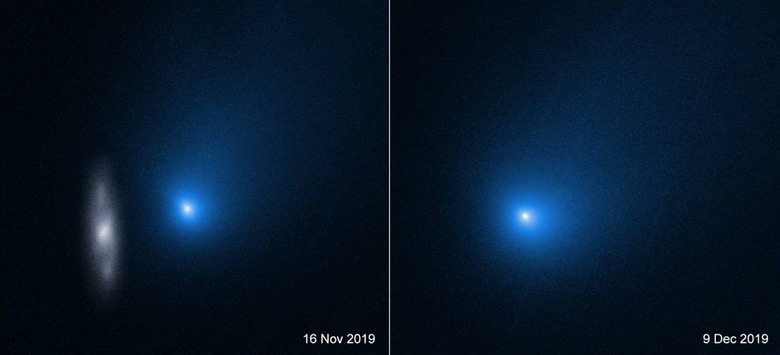Interstellar Comet 2I/Borisov Just Doubled-Down On Its Weird Mystery
The unexpected contents of an alien comet have left scientists scratching their heads, as the strange chemical properties of 2I/Borisov force experts to rethink what was assumed about neighboring star systems. Observed as it briefly passed through our own solar system in late-2019, 2I/Borisov may only be 3,200 feet long, but its 74,000 miles per hour speed have helped it rack up some serious distances.
Exactly where the comet started out is unclear. What was obvious when the first signs of its approach were spotted was that it would make a rapid pass through the solar system. In fact, 2I/Borisov's hyperbolic trajectory saw it swing around our Sun and then slingshot out back into deep space.
It was here long enough, though, to be within sight of telescopes, and that opened up the opportunity to see just what the comet might be made of. That included the Atacama Large Millimeter/submillimeter Array (ALMA), a vast collection of 66 dishes in northern Chile that work together as the world's most powerful radio telescope. A team lead by Martin Cordiner and Stefanie Milam at NASA's Goddard Space Flight Center pointed it at where 2I/Borisov was forecast to be in December last year.
The ALMA is capable of identifying the different chemicals outgassing from the comet, as it vaporizes from the heat of the Sun. Hydrogen cyanide was recorded first, confirming earlier reports about 2I/Borisov. However carbon monoxide proved to be the big surprise.

CO isn't rare in space. Indeed it's one of the most common molecules, and there being some in 2I/Borisov was predictable. However the quantity in the comet was "off the charts" according to the NASA researchers. A paper on their findings was published today in Nature Astronomy.
"As soon as the spectrum came in, we knew it was a significant result," NASA's Milam said of the findings. Compared to almost all other solar system comets, the CO recorded was exponentially greater. Only one other observed comet, C/2016 R2 (PanSTARRS) spotted in 2016, had a higher level. That, too, left scientists bemused.
Right now, there are only really theories to go on. One possibility is that it represents a vastly different chemistry that developed in a different planetary system; another is the chance that solar system comets in general have a much wider range of carbon monoxide than previously assumed. 2I/Borisov could be a broken chunk of a dwarf planet, even, rich in a CO crust and carrying a cache of that huge distances after a vast space collision.
Not all of the theories are so dramatic, mind. Another possibility is that the comet isn't vaporizing evenly, with other chemicals – like water and hydrogen cyanide – being released less rapidly than carbon monoxide. That might lead to it appearing disproportionately present in the rock.
The news comes shortly after a new theory about the mysterious 'Oumuamua, the unusually elongated "interstellar object" that was first sighted in 2017. Researchers in China and the US have suggested that its weird, cigar-shaped form could've been created by tide-like forces around an alien sun. 'Oumuamua left our solar system before expansive radio telescope readings could be taken of its chemical makeup.
